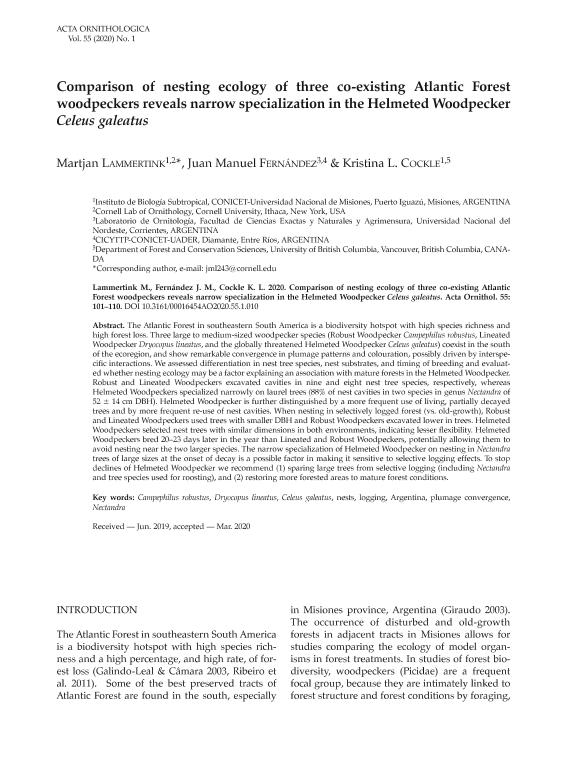Mostrar el registro sencillo del ítem
dc.contributor.author
Lammertink, J. Martjan

dc.contributor.author
Fernández, Juan Manuel

dc.contributor.author
Cockle, Kristina Louise

dc.date.available
2021-09-13T11:48:07Z
dc.date.issued
2020-06
dc.identifier.citation
Lammertink, J. Martjan; Fernández, Juan Manuel; Cockle, Kristina Louise; Comparison of nesting ecology of three co-existing Atlantic Forest woodpeckers reveals narrow specialization in the Helmeted Woodpecker Celeus galeatus; Polish Academy of Sciences. Museum and Institute of Zoology; Acta Ornithologica; 55; 1; 6-2020; 101-110
dc.identifier.issn
0001-6454
dc.identifier.uri
http://hdl.handle.net/11336/140170
dc.description.abstract
The Atlantic Forest in southeastern South America is a biodiversity hotspot with high species richness and high forest loss. Three large to medium-sized woodpecker species (Robust Woodpecker Campephilus robustus, Lineated Woodpecker Dryocopus lineatus, and the globally threatened Helmeted Woodpecker Celeus galeatus) coexist in the south of the ecoregion, and show remarkable convergence in plumage patterns and colouration, possibly driven by interspecific interactions. We assessed differentiation in nest tree species, nest substrates, and timing of breeding and evaluated whether nesting ecology may be a factor explaining an association with mature forests in the Helmeted Woodpecker. Robust and Lineated Woodpeckers excavated cavities in nine and eight nest tree species, respectively, whereas Helmeted Woodpeckers specialized narrowly on laurel trees (88% of nest cavities in two species in genus Nectandra of 52 ± 14 cm DBH). Helmeted Woodpecker is further distinguished by a more frequent use of living, partially decayed trees and by more frequent re-use of nest cavities. When nesting in selectively logged forest (vs. old-growth), Robust and Lineated Woodpeckers used trees with smaller DBH and Robust Woodpeckers excavated lower in trees. Helmeted Woodpeckers selected nest trees with similar dimensions in both environments, indicating lesser flexibility. Helmeted Woodpeckers bred 20-23 days later in the year than Lineated and Robust Woodpeckers, potentially allowing them to avoid nesting near the two larger species. The narrow specialization of Helmeted Woodpecker on nesting in Nectandra trees of large sizes at the onset of decay is a possible factor in making it sensitive to selective logging effects. To stop declines of Helmeted Woodpecker we recommend (1) sparing large trees from selective logging (including Nectandra and tree species used for roosting), and (2) restoring more forested areas to mature forest conditions.
dc.format
application/pdf
dc.language.iso
eng
dc.publisher
Polish Academy of Sciences. Museum and Institute of Zoology

dc.rights
info:eu-repo/semantics/openAccess
dc.rights.uri
https://creativecommons.org/licenses/by-nc-sa/2.5/ar/
dc.subject
ARGENTINA
dc.subject
CAMPEPHILUS ROBUSTUS
dc.subject
CELEUS GALEATUS
dc.subject
DRYOCOPUS LINEATUS
dc.subject
LOGGING
dc.subject
NECTANDRA
dc.subject
NESTS
dc.subject
PLUMAGE CONVERGENCE
dc.subject.classification
Zoología, Ornitología, Entomología, Etología

dc.subject.classification
Ciencias Biológicas

dc.subject.classification
CIENCIAS NATURALES Y EXACTAS

dc.title
Comparison of nesting ecology of three co-existing Atlantic Forest woodpeckers reveals narrow specialization in the Helmeted Woodpecker Celeus galeatus
dc.type
info:eu-repo/semantics/article
dc.type
info:ar-repo/semantics/artículo
dc.type
info:eu-repo/semantics/publishedVersion
dc.date.updated
2021-03-23T13:27:23Z
dc.journal.volume
55
dc.journal.number
1
dc.journal.pagination
101-110
dc.journal.pais
Polonia

dc.description.fil
Fil: Lammertink, J. Martjan. Consejo Nacional de Investigaciones Científicas y Técnicas. Centro Científico Tecnológico Conicet - Nordeste. Instituto de Biología Subtropical. Instituto de Biología Subtropical - Nodo Posadas | Universidad Nacional de Misiones. Instituto de Biología Subtropical. Instituto de Biología Subtropical - Nodo Posadas; Argentina
dc.description.fil
Fil: Fernández, Juan Manuel. Universidad Nacional del Nordeste; Argentina. Provincia de Entre Ríos. Centro de Investigaciones Científicas y Transferencia de Tecnología a la Producción. Universidad Autónoma de Entre Ríos. Centro de Investigaciones Científicas y Transferencia de Tecnología a la Producción. Consejo Nacional de Investigaciones Científicas y Técnicas. Centro Científico Tecnológico Conicet - Santa Fe. Centro de Investigaciones Científicas y Transferencia de Tecnología a la Producción; Argentina
dc.description.fil
Fil: Cockle, Kristina Louise. University of British Columbia; Canadá. Consejo Nacional de Investigaciones Científicas y Técnicas. Centro Científico Tecnológico Conicet - Nordeste. Instituto de Biología Subtropical. Instituto de Biología Subtropical - Nodo Posadas | Universidad Nacional de Misiones. Instituto de Biología Subtropical. Instituto de Biología Subtropical - Nodo Posadas; Argentina
dc.journal.title
Acta Ornithologica

dc.relation.alternativeid
info:eu-repo/semantics/altIdentifier/doi/http://dx.doi.org/10.3161/00016454AO2020.55.1.010
Archivos asociados
